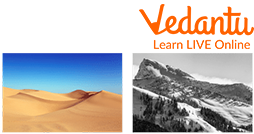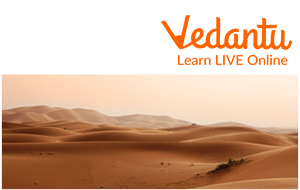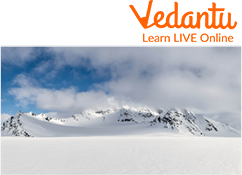




What are Cold Deserts?
Most of the time, when we hear the word "desert," we picture a heated, dry environment covered in sand and cactus vegetation. From dunes to camel rides, you have likely seen deserts in pictures and movies but did you know that not all deserts are hot? Some desert areas have a cold climate.
From coastal deserts to the largest ice desert in Antarctica, there is much to explore about deserts. Ladakh is a cold desert in India. Cold deserts have long and freezing winters with warm summers. In this article, we will discuss about cold deserts and fun facts about deserts.
Deserts
Deserts are areas with fewer than 10 inches (25 cm) of annual rainfall. Deserts are usually barren areas of the landscape where less precipitation occurs. These areas experience a lack of vegetation due to scarce resources.
Types of Deserts
The driest places on earth are deserts, but there are two different types of deserts: hot deserts and cold deserts.

Types of Deserts
Hot Deserts
The annual average temperature is high in hot deserts. The summer season is when the temperature is at its highest. Also, because of the higher rate of evaporation due to the high temperature, they are drier than cold deserts. Hot deserts usually have strong winds and clear skies. For example, the Thar desert is the largest hot desert in India.

Hot Desert
Cold Deserts
Cold deserts, also known as "temperate deserts,” have cold temperatures all year long. Due to the lack of air moisture, they experience dry weather with moderate to high winds and very little precipitation. Polar deserts are a type of cold desert. The polar deserts are extremely cold. It hardly rains there, and when it does, it usually snows.
Most of the world's cold deserts are found in temperate areas at higher latitudes, such as the Arctic, Antarctica, Greenland, Iran, Turkestan, Northern, and Western China as well as in the regions above mountain ranges' tree lines. They experience cold weather winters and slightly hot summers.
There is a lot of snowfall in the winter. The soil is saline, heavy, and silty. To minimise water loss, vegetation is covered with needle-like leaves. The dominant plants have mostly spiky leaves and are seasonal. Jackrabbits, foxes, kangaroo rats, kangaroo mice, pocket mice, grasshopper mice, and antelope ground squirrels are examples of widely spread animals. All animals, except jackrabbits, are burrowers. Deer are found only in the winter.

Cold Deserts
Common Facts about Cold Deserts
Some common facts about deserts that are cold are as follows:
Cold deserts are found on high plateaus or mountains in temperate regions.
Summers there are hot, while winters are extremely cold.
These deserts receive 15 to 26 cm of rainfall on average.
Atacama, Gobi, Great Basin, Namib, Iranian, Takla Makan, and Turkestan are a few well-known cold deserts.
The world's largest cold desert is found in Antarctica.
In the winter, the majority of the animals in these regions grow thick fur coats. They lose their fur coats in the summer.
In cold deserts, you can find plants like camel's thorns, shad scales, and grasses.
These deserts' snowfall makes it tough for vegetation to grow.
Ladakh is a cold desert located in the Eastern Jammu and Kashmir regions of the Great Himalayas.
There are few areas of grass and plants for animals to graze in Ladakh.
Interesting Facts about Deserts
Some interesting desert facts are as follows:
Iron and uranium mineral resources are found in some Australian deserts.
There are 1 billion people that live in desert areas worldwide.
The greatest cold desert on earth, Antarctica is an entire continent.
Plants in deserts store water. In times of drought, plants' leaves store water and use it to stay alive.
Except for the camels that transport travellers across the dunes, animals are not visible in deserts during the day. The majority of wildlife in the desert is active at night and only comes at night.
You can find more than 200 rattlesnakes in one square mile of desert.
Every desert has different weather. Deserts that are dry and hot are warm all year round and extremely hot in the summer. The rainfall happens in short times, and sometimes it doesn’t even hit the ground. Cool winters and relatively warm, long summers are characteristics of coastal deserts. Ice-covered deserts experience hot summers but cold winters.
The world's smallest desert is in Yukon, Canada. It is known as the Carcross Desert and is only one square inch mile in size.
The world's driest desert hasn't seen rain in more than 40 million years, according to research done by scientists. It’s called the Atacama desert, and to this day no records can be found of it getting any rainfall.
Summary
In this article, we discussed deserts and their interesting facts. Deserts are very important for the world because deserts' dry weather promotes the extraction and concentration of valuable minerals. Despite appearances, deserts are home to one-sixth of the world's people and make up more than one-fifth of the planet's land area. Every continent has deserts, and even though they lack water, they are essential for the survival of wildlife, people, and the environment.
FAQs on Facts about Cold Desert
1. Is Thar a cold desert or a hot desert?
The Thar desert is a hot desert. It is situated in Rajasthan. The Thar desert is the 9th largest subtropical desert and the 17th largest desert in the world. The desert, which covers 200,000 square kilometres, provides a physical barrier between Pakistan and India. 15% of the Thar Desert is in Pakistan, and the remaining 85% is in India. The Indian state of Rajasthan has 60% of the world's desert, and it also spreads into the states of Gujarat, Punjab, Haryana, and Sindh in Pakistan.
2. Which desert is considered the world's oldest?
The Namib desert is the world's oldest desert. On the southwest corner of Africa, the Namib desert has an area of 102,248 square miles. It also features some of the tallest sand in the world, rising to 1,300 feet.
3. What are the three largest deserts of the world?
Antarctic desert, Arctic desert, and Sahara desert are the three largest deserts of the world.









